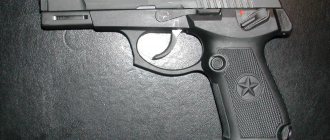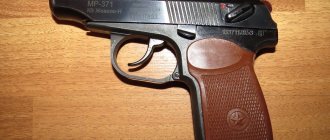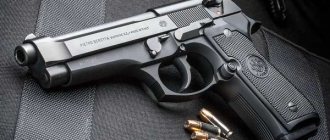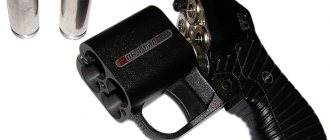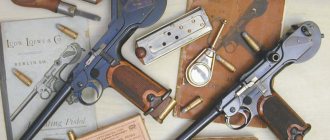A group of developers from the Naval Engineering University in Wuhan (PRC) managed to create a compact electromagnetic weapon of unprecedented power. The South China Morning Post reported this. Experts from Profile magazine assessed the capabilities of the new pistol and how realistic the imminent appearance of small electromagnetic weapons is.
The device is designed on the principle of a Gauss gun, has the form factor of a pistol with a barrel 12 cm long. Three electromagnetic coils are placed around the barrel, and the field generated by them is capable of ejecting a projectile with an initial energy of about 150 J. It is especially noted that such indicators were achieved through the use of artificial intelligence. No other details about the characteristics and capabilities of the Chinese “Gauss pistol” are reported.
If we compare an electromagnetic gun with a regular one
Of course, the 150 J declared by the Chinese is not enough for serious firearms. Let’s compare: a Makarov pistol (PM) bullet has an initial energy of about 300 J, a Browning M1900 of 7.65×17 mm caliber has a muzzle energy of about 250 J. And only the almost toy “ladies’ Browning M1906 with a barrel slightly more than 5 cm chambered for cartridge 6 .35×15.5 HR had a muzzle energy of around 100 J. The closest in characteristics to the product of Chinese gunsmiths is the so-called small-caliber rifle chambered for .22 LR.
Now about the principle of operation. The Gauss gun (named after the German scientist Carl Gauss ) is a type of electromagnetic mass accelerator, known since the 19th century. Today, even schoolchildren can assemble it from scrap materials - I personally first saw such a device in the school labor room in the mid-1980s. The Guass gun barrel is made of a dielectric, around which one or more solenoids (inductors) are placed. A ferromagnetic projectile or simply an iron bullet is loaded into the breech of the barrel. When current is passed through the coils, a magnetic field is formed, which draws the projectile into the solenoid and accelerates it. And most importantly: to fire a shot, a short-term and powerful electrical impulse is required. To obtain it, large capacitors are used.
Prototypes of “Gaussians” were tested back in the 30s of the last century, but it was never possible to build anything suitable for military purposes. Today, the Gauss accelerator as a weapon is considered practically futile, and to create combat systems, military designers use the principle of a railgun (another type of electromagnetic mass accelerator).
Type 51
The Chinese "Type 51" is a copy of the Soviet Tokarev TT-33 pistol. The Type 51 served as the service weapon of the Chinese army. This is a pistol with a short barrel stroke and a locked bolt. It does not have a safety lock, and the weapon is safe only if there is no cartridge in the chamber. "Type 51" is a crude and simple system. The trigger mechanism is designed in such a way that during disassembly it is removed as a single unit. Similar pistols were produced for the Hungarian armed forces.
What are Gauss rifles capable of?
But “Gauss” has become a mega-popular topic among amateur designers - on the Internet you can find a huge number of videos where companies or individual enthusiasts demonstrate their versions of Gauss rifles and machine guns of different sizes and power. They are used to shoot aluminum cans, laptop screens, etc.
In the USA, such devices are produced under the general name e-gun, and according to American law they are not considered weapons. One of the variants of the Gauss assault rifle was tested by the famous weapons blogger Matt Carriker on his YouTube channel “Demolition Ranch”. The device fired steel discs and had a bullpup layout - a magazine with “cartridges” was inserted behind the fire control handle. The machine made it possible to regulate the rate of fire and the initial speed of projectiles. In max mode, when shooting at point-blank range, a steel disk pierced a plastic soda bottle.
Blogger Matt Carriker tests a Gaussian machine. screenshot/Youtube.com
In July 2022, the American company Arcflash Labs introduced the GR-1 (Gauss rifle) electromagnetic rifle, a bulky device weighing 9 kg and about a meter long. It accelerated metal blanks with a diameter of 11-12.6 mm to a speed of 75 m/s, imparting to them an energy of 100 J. At the time of its appearance, the GR-1 was positioned as the most powerful “Gauss rifle” available to the general consumer. It can be assumed that if you “play” with the characteristics of the projectile, say, reduce the caliber and weight, then this system will be able to produce power indicators approaching those of a real pistol.
In the summer of 2022, the Chinese military news portal js7tv.cn demonstrated prototypes of assault rifles and Gauss pistols, as well as robotic platforms with these weapons. During the two-minute video, the Chinese in military uniforms ran and took threatening poses with their electromagnetic devices. Then the shooter from the miracle weapon, almost point-blank, pierced several sheets resembling thick hardboard and a sheet of very thin tin. Crawler robots the size of a children's toy crawled between the trees and shot balloons from several meters...
Chinese copies of M3A1 Grease Gun and Thompson submachine guns
When the US Submachine Gun, Caliber .45, M3, was officially adopted on January 11, 1943, some soldiers initially had to get used to its appearance. Although many derogatorily called it the Grease Gun, it quickly gained a good reputation due to its reliability.
After the end of World War II, thousands of American M3 submachine guns found themselves scattered around the world, serving officially or unofficially both with and against the law. Thanks to their simple design, the M3 and M3A1 models could be kept in functionally good condition by anyone with at least some ability in the craft. Some countries, such as China or Argentina, even mass-produced the Grease Gun.
After China was largely weakened as a state due to the civil war between the Nationalists (Kuomindang) and the Communists that had continued since 1927, Japan saw this as an opportunity to strengthen its dominant position in Asia and retain its mineral deposits in China . At the end of 1931, Japanese troops captured Manchuria after which, despite the armistice agreement, ground battles and air raids resumed. After the border incident on July 7, 1937, the Second Sino-Japanese War began.
A Chinese unit with its own Thompson submachine guns.
The Soviet Union supported Chinese troops because it feared the expansion of Japanese influence. Even anti-communist nationalists received weapons and equipment from the Soviet Union. However, help also came to China from the United States of America - they wanted not only to pin down the Japanese army, but also to gain China as an ally and a stable power in Asia after the war. As part of the Lend-Lease agreement from February 1941 until the end of the war, China received goods worth over US$1.6 billion. Along with the United Defense UD-42 submachine guns and various models of the Thompson submachine gun, a large number of Grease Gun submachine guns arrived in China.
Thompson 7.62x25 caliber submachine gun, manufactured in the Mukden Arsenal. It is an exact copy of the American prototype.
Many weapons were not used directly by opponents in battle in the civil war - they were stored in anticipation of the outcome of the internal confrontation. While the Kuomintang fought fiercely against the Japanese and suffered heavy losses, the Communists avoided major battles in order to conserve their strength in anticipation of the fight against the Kuomintang. As expected, after Japan's surrender, civil war broke out again. With the war ongoing, the US tried to find a peaceful solution with the leaders of both sides: Mao Zedong (communists) and Chiang Kai-shek (nationalists). However, these intentions failed. Although, thanks to further assistance from the United States, the Kuomintang were able to keep Manchuria under their control until the fall of 1945, but in the end, at the beginning of 1949, they were forced to surrender. With their leader Chiang Kai-shek, they retreated to the island of Formosa (today Taiwan), while on the Chinese mainland, communist leader Mao Zedong proclaimed the creation of the People's Republic of China on October 1, 1949.
Chinese copies of Thompson and M3A1
In the years after the Japanese surrender, the nationalists produced submachine guns at their arms factories - copies of the American Thompson and M3A1 models. Both types of weapons are not easy to make. The Thompson submachine gun requires extensive milling machinery and well-trained workers. And even the M3A1 model requires numerous dies, powerful presses and a high degree of precision when welding parts of the receiver. The American company Guide Lamp has already had its difficulties in this matter.
The Chinese arsenal in the city of Nanjing in 1865. Noticeable are rockets with a firing machine.
It is not known where the machines and stamps came from, and whether the United States had a hand in this when organizing the production of weapons. But this assumption is quite realistic, since the Chinese version is an exact copy of the original and is so similar in appearance that they can be confused. There are no design deviations, no simplifications or improvements. Even the knurling pattern of the handle is copied exactly. Other weapons, such as the Russian PPSh-41 or PPS-43 submachine guns, would be much easier to produce.
First produced an arsenal in Mukden
The first copy was the Modell 36, named in 1947 according to the Chinese calendar (which begins with the first year of the establishment of the Republic of China - January 1, 1912). Weapons began to be manufactured at the 90th Arsenal in the city of Shenyang, the capital of Manchuria in northeast China. Before the Japanese occupation the city was called Mukden. On the magazine receiver was the symbol of the 90th Arsenal: the number 9 above the number 0 in a circle, separated by a crossbar.
Model 36 original caliber .45 ACP (bullet diameter 11.43 mm). The inscription on the magazine receiver means in Russian: “Model 36” and under this “11-mm submachine gun”. Serial number 01788.
The production workshops in Mukden had a history rich in change. Originally founded by Chinese general and later marshal Zhang Zuolin in Russian-occupied Manchuria, Mukden-Arsenal produced ammunition for the Russian army. The Japanese were able to occupy the city on March 10, 1905, after a major battle during the Russo-Japanese War. Although Manchuria was again transferred to China, Japan retained its economic influence and built the South Manchurian Railway to Korea in order to be able to more easily transport raw materials to the mother country. To protect the railway track, primarily from capture by the Russians, Japan stationed the Kwantung Army (also called the Guangdong Army) in Manchuria.
Model 37 bolt chambered for 9mm cartridge.
In September 1931, the “Mukden Incident” occurred, a provocative explosion that damaged railway tracks, with the goal of the complete capture of Manchuria by Japanese troops and the creation of the puppet state of Manchukuo under the regency of Pu Yi. With the sudden outbreak of the second Sino-Japanese War in July 1937 Japanese Nanman-Arsenal was spun off from the plant. In this regard, the arsenal was also renamed Hoten-Arsenal. From 1938 to 1945, the plant produced large quantities of ammunition for the Japanese army. After Japan's surrender, Chinese nationalists took over Hoten-Arsenal and renamed it 90. Arsenal in 1946.
Chinese submachine guns from 36 to 39
For the civil war against the communists, weapons were urgently needed. In this situation, in 1947, the reproduction of the M3A1 Grease Gun submachine gun of the original .45 ACP caliber began in the form of Modell 36. What is striking is the design of the barrel mount in the style of the old M3 model without key surfaces and the absence of an oiler in the hollow handle. The magazine receiver has an inscription in Chinese. Unfortunately, there is no exact data on the production period and the number of copies produced. However, according to information from Chinese sources, at least 10 thousand submachine guns were to be manufactured before the plant was commissioned.
1. The Model 37 9mm arose due to a shortage of .45 ACP cartridges. An attached adapter is visible in the magazine receiver. A ledge at the base of the barrel is visible, a clear sign of a 9mm model. 2. Adapter for Model 37 magazine receiver for 9x19 caliber cartridges. The later Model 39 did not need this adapter. 3. Separated bolt of the Chinese model 37 chambered for the 9mm cartridge.
In terms of workmanship, these weapons still did not reach the American level. During assembly, it was still necessary to modify individual parts manually, and therefore subsequent replacement of defective parts was not always possible without problems. When attempting to replace some museum gun barrels, differences in the threads were discovered, and the holes at the end of the receiver to accommodate the bolt guide rods were slightly different on all weapons.
Property mark: arrow and bow in a cogwheel. The round symbol underneath is the manufacturer's mark. Model 38 9mm, made in Taiwan. Bulges are visible on the sides of the magazine receiver.
Soon, due to a shortage of .45 ACP cartridges, the nationalists found an alternative - and from 1948 they produced the Grease Gun in 9x19 caliber. The parts used for it, especially the magazine receiver adapter, were very similar to the American 9mm conversion kit. He probably served as a model. Of course, it is unknown whether the magazines were made in China or whether we are talking about magazines used for the British Sten submachine gun.
In accordance with the Chinese calendar, the submachine gun was designated Modell 37. Its production was carried out at Arsenal 60. Ji-Ling-Arsenal in Nanjing, at that time the capital of the Republic of China. The magazine receiver bore the Chinese military's own mark: an arrow and a bow in a cogwheel. It is not clear why the Russian 7.62x25 caliber cartridge was not used, but therefore the use of captured cartridges from a communist enemy supported by the USSR was impossible.
Latest model: Made in Taiwan since 1950, the Model 39 had a screw-on curved barrel as an accessory, as well as a rubber hand guard.
As the civil war progressed, the Nationalists were unable to hold out against the Communists and retreated to the island of Formosa (today's Taiwan/Republic of China) in early 1949. At the same time, they also took with them the equipment and machine park to create new production facilities in Kaoshung (205. Arsenal).
Opening: A Chinese officer demonstrates the new American M3 submachine gun.
On this occasion, the design of the submachine gun was redesigned: the magazine receiver was narrowed to accommodate magazines for 9-mm cartridges - there was no need for a separate adapter device and constant delays in chambering cartridges became a thing of the past. A noticeable change is the bulges on the sides of the magazine receiver, since the stamped stops on the magazines for the Sten submachine gun are located significantly higher than on the magazines of the M3 or M3A1 models. Already in 1950, the first types of weapons could be manufactured in Taiwan, now called Modell 39. As accessories there was a sound muffler and a curved barrel, which was fixed movably and could be rotated in any chosen direction. The rubber thickening served to protect the shooter’s hand from burns, so for better stabilization when shooting, the weapon could be held firmly by the barrel.
Michael Heidler Translation by Nikolai Yezhov
What does artificial intelligence have to do with it?
Experts look at the Chinese new product, as well as at the prospects of Gauss guns as small arms, with undisguised skepticism.
“The statement about artificial intelligence casts doubt,” said military expert Konstantin Bogdanov . “In these devices, it all comes down to energy consumption: what impulse is given, the projectile flies.”
One of the problems of Gauss systems is low efficiency, for example, for the GR-1 rifle it is only 2.8%. Therefore, a possible direction for improvement is the creation of superconducting coils (which brings with it new difficulties) or replaceable capacitor banks.
Mikhail Degtyarev, editor-in-chief of the Kalashnikov magazine, shared his doubts . “I don’t understand what needs to happen for a compact system with the characteristics of a military weapon to appear in the coming years.”
The most likely trend in the development of electromagnetic weapons was considered to be the creation of ship guns based on railguns - in America they are called railgun, “rail gun”. In 2005, the US Navy announced a program to create Velocitas Eradico “rail guns”. It was assumed that such a weapon would be able to fire a projectile at a speed of 8.5 km/s to a range of up to 400 km. Destroyers of the Zamvolt class were to be armed with them. There were tests that caused a lot of noise, then the program stalled, and in 2021 its funding was stopped. One of the main reasons is the lack of sufficiently compact power supplies. And this was on a ship where a whole compartment was allocated for the power plant and capacitor batteries for the railgun!
Finally, this is an illustration: we managed to find a video where a British amateur designer demonstrates a “portable” rail gun capable of breaking through the skin of a car. The system weighs 113 kg and has the dimensions of a heavy machine gun, and the battery of capacitors for it almost completely occupies the trunk of a passenger car.
QS-Z-92
This is a modern combat pistol adopted by the People's Liberation Army of China. Automation uses recoil energy with a short barrel stroke; the bolt is locked by turning the barrel. The frame is plastic. The pistol is equipped with a guide for mounting a laser sight or tactical flashlight. The pistol is produced in two calibers - for the common 9 mm Parabellum cartridge and for the 5.8 mm Chinese cartridge with a bottle sleeve. It is believed that development of the pistol began in 1994.
Share link

